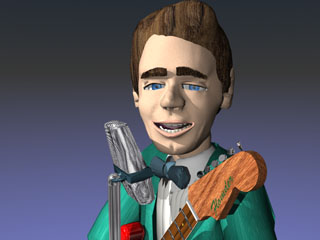|
|
|
GALLERY CONTINUED
PAGE FORTY-SIX

This head used one of the techniques not much recommended, but worth remembering: a subdivided box. 30 lines by 30 lines, later mirrored and welded (BGConform welded), followed by smooth shifting the top row of polygons when there wasn't enough detail for a forehead. It may not look like much, but there is a mouth interior and white eye sockets, and the nose and lip detail are adequate for either photoreal or character purposes.
The only drawback of the grid approach that I can think of is the lack of "edge loops." These do two things: they reduce rectilinear "jaggies" that show up wherever points are dragged, and they provide better animation, since these folds theoretically will flow better when magnetting and rotating gestures. "Pole 2" can "add" edge looping to some degree.
Edge loops are only the beginning of the subtlety one comes to expect of great animation. The modeller who lends a "Disney feel" to bookcases and candlesticks as well as dinosaurs and guinea pigs, one presumes will find a workstation waiting. That "feel" may imply a whole lot of assimilation: from Preston Blair through to the most recent features. As for the style of "animation:" the four-head VCR makes it possible for anyone studying animation to create a compelling work by imitating and building-on both the 2D and 3D traditions. Morph pose head "targets" allow one to play with loose jaws, deforming eyebrows, bulging eyes and chattering teeth, which can include squash and stretch by using "gross" deformer tools like "Vortex," "Twist" and "Bend." LIGHTWAVE animators are even programming bones to emulate these effects, since the new program versions include easily pasted keyframe branches.
I didn't provide a body for the head initially because I almost always use the hands provided with INSPIRE. They are so nice. But now there is a complete body in the "Freebs" section. The complete body also has better eyelids and jawline and a smaller mouth. Once again: if you do not want to MODEL, only ANIMATE, that's fine, GO FOR IT!
The head you see was flat as a board. The only parts that were smooth-shifted were the ears, nose and mouth/lips, using stretch and move, and the eyelids, using a trick shown by Larry Schultz where one creates an arch-shaped row of polygons (using rotate) and then "smooth-shifts" them BACKa few times using "Vortex" pivotting from the corner of the eyelid, with the cross-hair where the lash peak is. Vortex is a little weird, having the hot spot move faster than the pivot point, non-Keplerian. After I morphed them open, just to have a look at a quick mock-up, the mock-up looked so good I actually reselected the eyelids and "smoothed" them back and apart to be closed. "Smooth" is really good for returning geometry this way.
White eye-sockets are a great idea when time is short; I heard that this is what they do at Disney. This head was just a "test" for the real model, since the eyes are supposed to stay closed until the final model, but I'm pretty happy with it. It would do for "Thunderheads," a parody of puppet animation featuring some notions I've scribbled down. Two fixes: now I know why so many shows lay so much rouge on the character faces, and new eyebrows.
Eyebrows are a little tricky with INSPIRE, because they are probably going to be bones-rigged, but need to have polygons indicating position, with the whole forehead "mapped" with the brow as specularity, bump, diffusion, transparency and texture, a lot of trouble for a few hundred follicles. Watch people talk, and you'll see why this kind of work may be needed. Up go the eyebrows, down go the eyebrows,...
< BACK . . . . . . . . . . . . . . < HOME > . . . . . . . . . . . . . . NEXT >